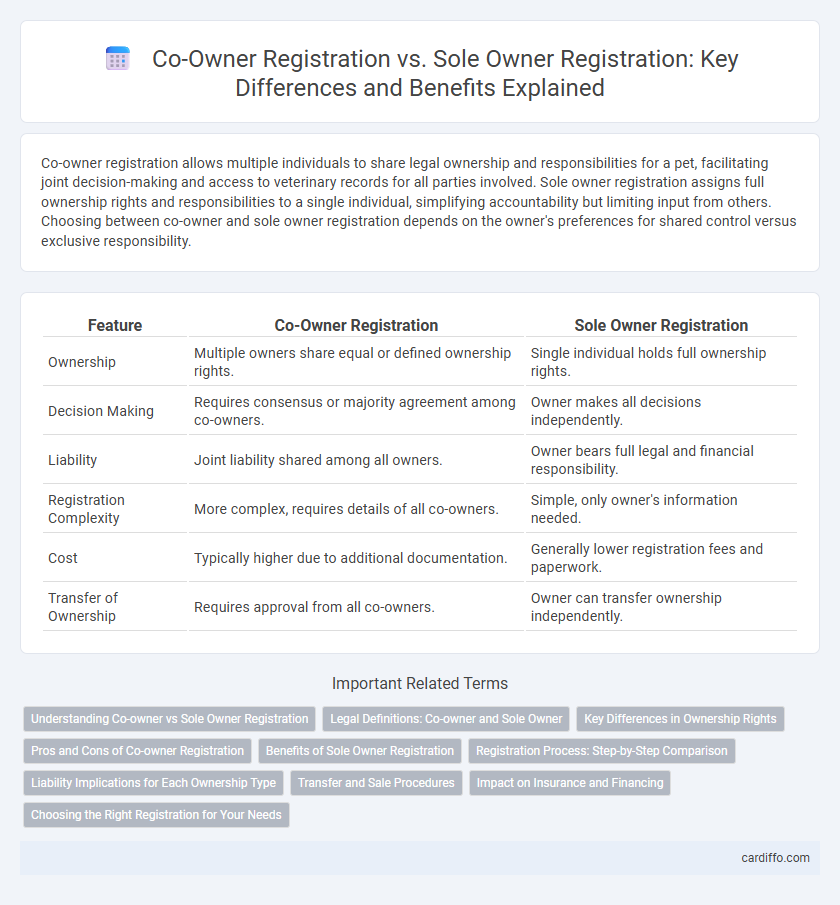Co-owner registration allows multiple individuals to share legal ownership and responsibilities for a pet, facilitating joint decision-making and access to veterinary records for all parties involved. Sole owner registration assigns full ownership rights and responsibilities to a single individual, simplifying accountability but limiting input from others. Choosing between co-owner and sole owner registration depends on the owner's preferences for shared control versus exclusive responsibility.
Table of Comparison
| Feature | Co-Owner Registration | Sole Owner Registration |
|---|---|---|
| Ownership | Multiple owners share equal or defined ownership rights. | Single individual holds full ownership rights. |
| Decision Making | Requires consensus or majority agreement among co-owners. | Owner makes all decisions independently. |
| Liability | Joint liability shared among all owners. | Owner bears full legal and financial responsibility. |
| Registration Complexity | More complex, requires details of all co-owners. | Simple, only owner's information needed. |
| Cost | Typically higher due to additional documentation. | Generally lower registration fees and paperwork. |
| Transfer of Ownership | Requires approval from all co-owners. | Owner can transfer ownership independently. |
Understanding Co-owner vs Sole Owner Registration
Co-owner registration involves multiple individuals sharing legal ownership and responsibilities of a property, which can impact decision-making and liability distribution. Sole owner registration grants full ownership and control to a single individual, simplifying transactions but placing all risks solely on that owner. Choosing between co-owner and sole owner registration depends on factors like financial contributions, desired control, and inheritance planning.
Legal Definitions: Co-owner and Sole Owner
Co-owner registration legally recognizes two or more individuals sharing ownership rights and responsibilities over a property or asset. Sole owner registration defines exclusive ownership by a single individual, granting complete control and liability. Understanding these distinctions is crucial for determining legal authority, inheritance rights, and financial obligations in property documentation.
Key Differences in Ownership Rights
Co-owner registration grants multiple individuals equal or specified shares of ownership rights, allowing them joint decision-making authority and shared responsibility over the property, whereas sole owner registration assigns full ownership and exclusive control to a single individual. In co-ownership, rights such as possession, use, and disposition are typically divided according to agreements or legal frameworks like joint tenancy or tenancy in common. Sole ownership simplifies legal processes with undivided rights, but limits flexibility in transfer or sale compared to the complexities and protections inherent in co-owner arrangements.
Pros and Cons of Co-owner Registration
Co-owner registration offers shared responsibility, which can ease financial burdens and improve decision-making through collaboration, but it may lead to conflicts if owners disagree on property management or use. It enhances estate planning flexibility by allowing interest transfer to surviving co-owners without probate, yet increases complexity in legal documentation and potential tax implications. Joint ownership also poses risks if one owner encounters legal or financial issues, possibly affecting the entire asset.
Benefits of Sole Owner Registration
Sole owner registration offers streamlined decision-making and full control over business operations without the need for consensus from others. This structure provides simplified tax filing and minimized legal complexities compared to co-owner registration. Sole ownership also ensures that all profits directly benefit the individual owner, enhancing financial clarity and personal accountability.
Registration Process: Step-by-Step Comparison
Co-owner registration requires submitting ownership documents for all parties involved, verifying each individual's identity, and signing a joint agreement, whereas sole owner registration involves a single owner's documents and signature. The co-owner process typically takes longer due to multiple identity verifications and consensus requirements, while sole owner registration is more straightforward and faster. Both processes involve submitting the relevant property title, filling out standardized forms, and paying registration fees to the appropriate government authority.
Liability Implications for Each Ownership Type
Co-owner registration divides liability among all registered parties, meaning each co-owner is individually responsible for the entire liability in case of legal or financial obligations. Sole owner registration places full liability solely on the individual owner, exposing them to complete risk without shared accountability. Understanding these liability implications is crucial for selecting the appropriate ownership structure to mitigate potential legal and financial risks.
Transfer and Sale Procedures
Co-owner registration requires all parties to consent during transfer and sale procedures, ensuring joint decision-making and shared liability. Sole owner registration simplifies the process by allowing the individual owner to independently execute transfer or sale transactions without needing additional approvals. Transfer of ownership in co-registered properties involves drafting an agreement that acknowledges each co-owner's rights, while sole ownership facilitates a more straightforward title transfer.
Impact on Insurance and Financing
Co-owner registration often leads to shared liability and can improve financing options by combining creditworthiness, which may result in better insurance premiums due to distributed risk. Sole owner registration simplifies claims and loan approvals but may limit borrowing power and lead to higher insurance costs as the risk is borne by one individual. Understanding the distinctions in ownership registration is crucial for optimizing both insurance coverage and financing opportunities.
Choosing the Right Registration for Your Needs
Co-owner registration allows multiple individuals to share legal ownership, distributing responsibilities and benefits, which is ideal for partnerships or shared investments. Sole owner registration grants exclusive control and full rights to a single person, simplifying decision-making and liability management. Selecting the right registration depends on your financial goals, risk tolerance, and intended level of control over the property or asset.
Co-owner registration vs Sole owner registration Infographic

 cardiffo.com
cardiffo.com